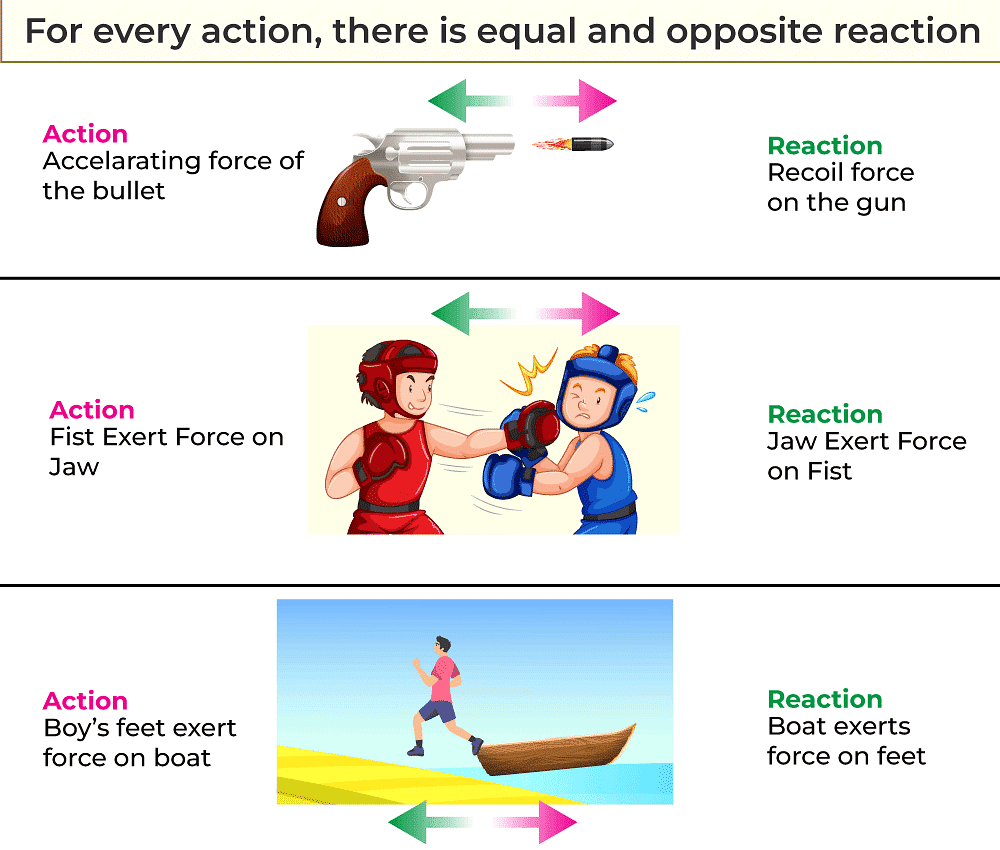Newton's Third Law of Motion | Physics for Airmen Group X - Airforce X Y / Indian Navy SSR PDF Download
| Table of contents |

|
| What is Newton’s Third Law Of Motion? |

|
| Newton’s Third Law Equation |

|
| Application in Aerodynamics: Rocket Propulsion |

|
| Examples of Interaction Force Pairs |

|
| Important Questions for Exam |

|
When we press a spring, the spring is compressed by the force of our hand. In turn, the spring also exerts a force on our hand and we can feel it. Again, the earth pulls a stone downwards due to gravity. According to Newton, the stone exerts an equal and opposite force on the earth.
In this document, we will study Newton's Third Law of Motion which explains the origin of force on a body.
What is Newton’s Third Law Of Motion?
Newton’s third law states that “If one object exerts a force on another object, then the other object exerts an equal and opposite force on the first object”.
- An example of Newton’s third law is a book lying on a table, as shown in the image below. The book applies a force on the table, which is the book’s weight. In order to prevent deformation, the table exerts an equal and opposite force on the book. This force is the normal force.
 Newton's Third Law
Newton's Third Law
- Force is a push or pull acting on an object resulting in its interaction with another object. Force is a result of an interaction. Force can be classified into two categories: contact force such as frictional force and non-contact force such as gravitational force.
- Action Reaction Pairs: According to Newton, when two bodies interact, they exert force on each other, and these forces are known as action and reaction pairs, which is explained in Newton’s third law of motion.
- Newton’s third law of motion states that: “When one body exerts a force on the other body, the first body experiences a force which is equal in magnitude in the opposite direction of the force which is exerted”.
The above statement means that in every interaction, there is a pair of forces acting on the interacting objects. The magnitude of the forces are equal and the direction of the force on the first object is opposite to the direction of the force on the second object.
 Illustrations of Newton's third law of motion
Illustrations of Newton's third law of motion
Newton’s Third Law Equation
Suppose an object A exerts a force FAB on object B, and the latter exerts a force FBA on the former. Then, Newton’s third law can be written as,
FAB = – FBA
In other words,
Action = – Reaction
Application in Aerodynamics: Rocket Propulsion
- The motion of a jet engine/rocket produces thrust hot exhaust gases flow out the back of the engine, and a thrusting force is produced in the opposite direction.
- Thrust is the power that propels an aircraft in the air, and it originates from the aircraft's propulsion system.
- Various propulsion systems create thrust using various methods, yet they all adhere to Newton's third law of motion, which states that for every action, there is an equal and opposite reaction.
- In any propulsion system, a working fluid gets accelerated by the system, and this acceleration leads to a force acting on the system. A fundamental derivation of the thrust equation illustrates that the thrust generated relies on both the mass flow passing through the engine and the velocity at which the gas exits the system.
 Illustration of Rocket Propulsion
Illustration of Rocket Propulsion
- Figure (a) shows the rocket has a mass of m and an upward velocity of v. The net external force on the system is −mg if air resistance is neglected.
- Figure (b) shows that a time Δt later the system has two main parts, the ejected gas and the remainder of the rocket. The reaction force on the rocket is what overcomes the gravitational force and accelerates it upward.
- Acceleration of a rocket is :
 where a is the acceleration of the rocket, u is the exhaust velocity, M is the mass of the rocket, dM is the mass of the ejected gas, and dt is the time in which the gas is ejected.
where a is the acceleration of the rocket, u is the exhaust velocity, M is the mass of the rocket, dM is the mass of the ejected gas, and dt is the time in which the gas is ejected.
- The greater the exhaust velocity ve of the gases relative to the rocket, the greater the acceleration.
- The faster the rocket burns its fuel, the greater its acceleration.
- The smaller the rocket’s mass (all other factors being the same), the greater the acceleration.
Example 1: For rocket propulsion, the velocity of exhaust gases relative to the rocket is . If the mass of the rocket is 1000 kg. What is the rate of fuel consumption for a rocket to rise up with an acceleration of 4.9 m/s2?
Solution : 
Example 2: Aswini and Deepa are standing on identical skateboards. Aswini and Deepa push off of each other and travel in opposite directions. If Aswini (M) and Deepa (m) have identical masses, who travels farther?
Solution: Neither. Both will travel the same distance because the force applied to each will be the same.
Ma = ma
a = a
Acceleration controls how far each of them will travel. Since both have the same acceleration, they travel equal distances.
The mathematical representation of Newton’s third law of motion is let A be the body exerting force  on body B, then body B exerts a force
on body B, then body B exerts a force  on body A, which is given as:
on body A, which is given as:
Newton’s third law of motion is associated with the conservation of momentum. According to the law for every action, there must be an equal and opposite reaction.
Examples of Interaction Force Pairs
A variety of action-reaction pairs are evident in nature. We have listed a few below, and they are as follows:
- Propulsion of Fish through Water: The propulsion of fish through water is an example of an action-reaction pair. A fish makes use of its fins to push water backward. This push serves to accelerate the fish forward. The size of the force on the water equals the size of the force on the fish; the direction of the force on the water (backward) is opposite the direction of the force on the fish (forward).
 Propulsion of Fish
Propulsion of Fish
- Flight of the Bird: The flight of the bird is an example of an action-reaction pair. The wings of the bird push the air downwards. The air pushes the air upwards.
 Flight of the Bird
Flight of the Bird - Swimmer: A swimmer pushes against the water, while the water pushes back on the swimmer.
 Swimming
Swimming
- Lifts: Lift is created by helicopters by pushing the air down, thereby creating an upward reaction force.
- Rock Climbers: Rock climbers pull their vertical rope downwards to push themselves upwards.
Important Questions for Exam
Question 1: While driving down the road, a firefly strikes the windshield of a bus and makes a quite obvious mess in front of the face of the driver. This is a clear case of Newton's third law of motion. The firefly hits the bus and the bus hits the firefly. Which of the two forces is greater: the force on the firefly or the force on the bus?
Solution: Each force is the same size. For every action, there is an equal reaction. The fact that the firefly splatters only means that with its smaller mass, it is less able to withstand the larger acceleration resulting from the interaction.
Question 2: Many people are familiar with the fact that a rifle recoils when fired. This recoil is the result of action-reaction force pairs. A gunpowder explosion creates hot gases that expand outward allowing the rifle to push forward on the bullet. Consistent with Newton's third law of motion, the bullet pushes backward upon the rifle. The acceleration of the recoiling rifle is____________ (greater/ smaller/ same) as the acceleration of the bullet.
Solution: The force on the rifle equals the force on the bullet. Yet, acceleration depends on both force and mass. The bullet has a greater acceleration due to the fact that it has a smaller mass. Remember: acceleration and mass are inversely proportional.
Question 3: The forces involved in Newton’s third law act ____
a) On the same object
b) On different objects
c) In same direction
d) On five bodies
Answer: b
Explanation: The two forces involved in Newton’s third law are the cause force and the reaction force. The cause force acts on the contact surface or the contact body by the parent body. Whereas the reaction force acts on the parent body by the contact body.
Question 4: A batsman hits a ball with a force a 5 N. What force does the bat experience?
a) 5 N
b) 10 N
c) 15 N
d) 20 N
Answer: a
Explanation: From Newton’s third law we know that for every for every action, there is an equal and opposite reaction. From this we can say that the bat experiences a force of 5 N.
Question 5: A truck with a mass of 2500 Kg travelling with an acceleration of 5 m/s2 hits a scooter. What force does the truck experience?
a) 12500 N
b) 500 N
c) 10000 N
d) 2500 N
Answer: a
Explanation: From Newton’ second law we get force on scooter = 2500 x 5 = 12500 N. From Newton’s third law we know that for every for every action, there is an equal and opposite reaction. From this we can say that the truck experiences a force of 5 N.
Question 6: A man and a kid accidentally hit each other. What is true about the forces experienced by them?
a) They are equal in magnitude
b) They are different in magnitude
c) They are same in direction
d) They are at an angle of 1.57 rad
Answer: b
Explanation: From the third law of motion, we know that the cause force and the reaction forces are equal in magnitude and opposite in direction. Hence, from this knowledge, we can say that the man and the kid will experience forces in opposite directions and in equal magnitude.
|
199 videos|422 docs|281 tests
|
FAQs on Newton's Third Law of Motion - Physics for Airmen Group X - Airforce X Y / Indian Navy SSR
| 1. What is Newton's third law of motion? |  |
| 2. How is Newton's third law of motion applied in aerodynamics, specifically in rocket propulsion? |  |
| 3. Can you provide examples of interaction force pairs based on Newton's third law of motion? |  |
| 4. How is Newton's third law of motion related to rocket propulsion? |  |
| 5. What are some solved examples of Newton's third law of motion in everyday life? |  |

|
Explore Courses for Airforce X Y / Indian Navy SSR exam
|

|



















